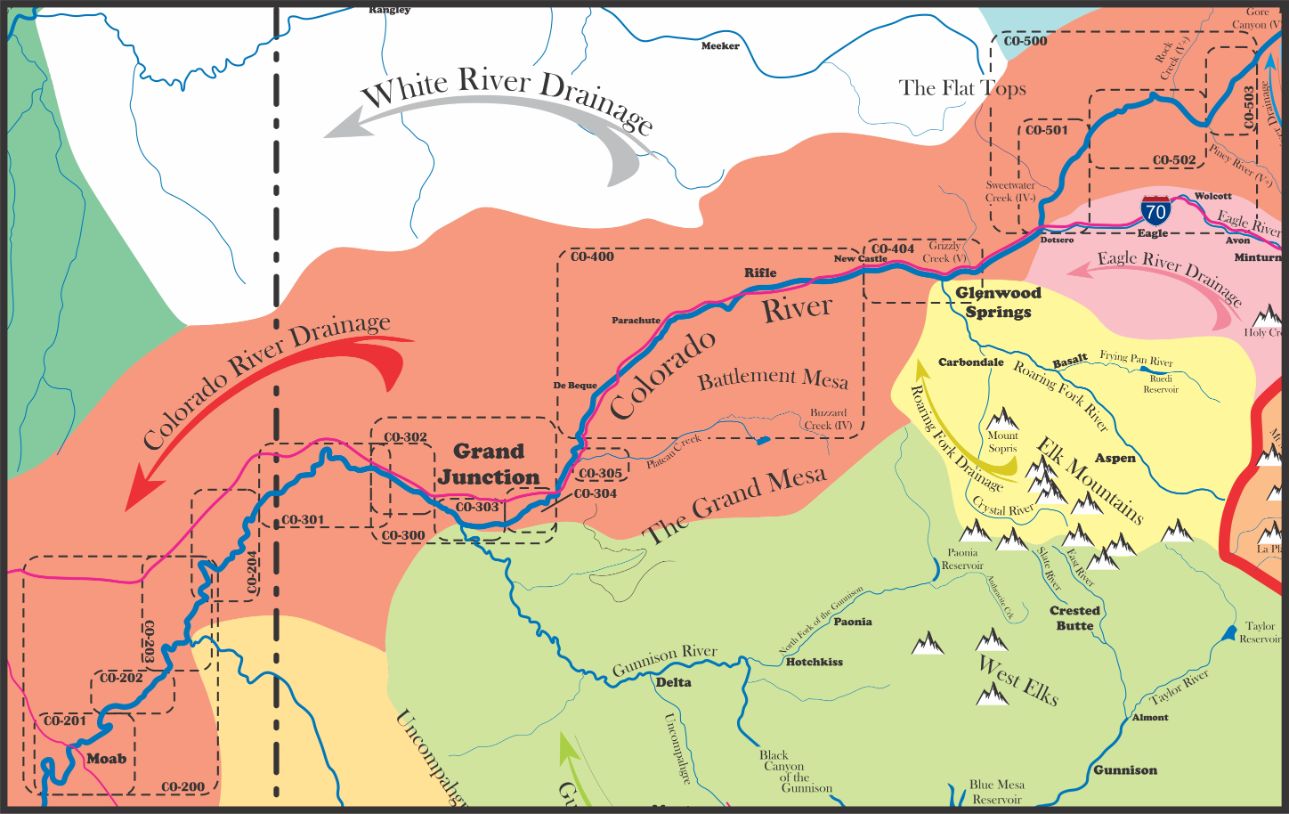Colorado
River
To help people find the section they are looking for we have split up the maps by area.
The headwaters of the Colorado River are high up in the Rocky Mountains, inside Rock Mountain National Park, at La Poudre Pass, elevation of 10,174′. Also known as the “River of Law” it gets its nickname because of the number of lawsuits over water rights that have set legal precedents used all over the country. The river used to flow all the way to the Sea of Cortez (Gulf of California) but as it flows through the desert southwest, water rights from 5 states and Mexico draw every drop of water to the point it no longer reaches the ocean, most years. Most of the water rights for this river basin were set during what can considered flood years and multiple years of “drought” have led to the major reservoirs along the way being at dangerously low levels. This is the desert, and this is the only real flow through this otherwise inhospitable environment. California’s Imperial Valley is a large user of this water but they do supply a large quantity of the country’s vegetables in the winter time. Cities likes Phoenix (population 4.8million) and Las Vegas (population 2.2million) rely entirely on the Colorado River Basin for their water and those cities “need” their lawns and golf courses.
The first straw that is put in the Colorado River starts at its headwaters with the Grand Ditch diverting water from the Never Summer Mountains over the La Poudre Pass where it ends up in the Cache La Poudre River on its way to the Mississippi River and eventually the Gulf of Mexico. This ditch diverts an average of 20,000 acre feet of water to Long Draw Reservoir on the other side of this pass. Started in 1890 the original diversion only went a few miles into the Never Summers but by the 1930s the reservoir was built and the diversion was extended 14.3 miles diverting 20%-40% of the water having an ecological impact on the water shed area below. The National Park Service has fought the amount of water taken to protect this eco system. Diversions like this happen all over the Rockies. This is merely one place where water is diverted out of the Colorado River Basin over the continental divide and on its way to irrigate crops on the eastern plans of Colorado and into Kansas, Nebraska, Oklahoma and the other farm belt states that provide our food.
Before we complain too much about all of the water rights and reservoirs, as boaters we do need to also think about the water that is held back creating a more prolonged runnable season on several of the rivers in the mountains and deserts. Before reservoirs we only had water during the snow melt and it was feast or famine but it could also be so high that it wasn’t runnable at all, at least not safely, and sometimes it was so high it wiped out entire towns. Reservoirs hold back some of the water to release for irrigation and city drinking water making several rivers still runnable much later into the season. Reservoirs do have their negative impacts as well, several fun rapids are now under thousands of acre ft of water, Pump House and the lower part of Gore Canyon were almost among them, but for every advantage there is a disadvantage, we can look at the negatives or be happy with the positives.
Character of the River:
Starting high up in Rock Mountain National Park the headwaters of the Colorado River is hardly a trickle as it’s starts it journey dropping almost 2,000 ft in elevation over 25ish miles as it heads into Shadow Mountain Lake, then Lake Granby. This is where the first real runnable section starts as it picks up flow from several tributaries coming out of the Indian Peaks. The Colorado continues through the mountains till about New Castle where it goes into a high desert environment. After it goes through the Grand Valley the river starts to cut through the deep maroon sandstone capping the black Precambrian metamorphic rock found in Ruby/horsethief and Westwater. The river continues to cut through this beautiful maroon/tan sandstone on its way into Lake Powell and beyond.
As it winds its way down through Colorado and Utah it provides several fun sections of flat and whitewater making a fun environment for all types of boaters and fishermen. Notable whitewater sections include the Upper C’s Gore Canyon and Pumphouse Run, the Glenwood Area’s Barrel Springs and Shoshone, then it’s relatively flat with a smattering of holes at different flows till you get to Westwater as you cross the CO/UT border. After Westwater it’s mostly flat again with the Moab Daily providing a few class III/IV rapids over a 13 mile stretch then the next big whitewater is Cataract Canyon that takes you into Lake Powell. In between these whitewater runs are some long beautiful stretches of flat water calling out to recreational canoeist, SUP Boarders, or anyone looking for a mellow day on the river.
Fishing:
If you’re looking to fish there are a lot of opportunities all along the flow depending on what you want to go after. Higher up you can catch largemouth bass, trout, striped bass, and a few other cold-water fish but as the river leaves Glenwood and starts to wind through the desert the water warms up and you start to find more channel cat, Humpback Chub, Bonytail Chub, Razorback Sucker, Flannelmouth Sucker, Bluehead Sucker, and a few others, many of which are endangered so make sure you know which ones you have to throw back. I personally have never seen anyone fishing the Colorado below Glenwood but know a few people that go after the channel cats, to each their own.
History of the name:
The name Colorado is Spanish for “colored red” or “red colored” and it was given to the river by the early Spanish settlers as they explored “The West”, or to them it was “The North”, and found a river so rich in sediment it was dyed red as it cut through the sandstone layers of the Colorado Plateau and Grand Canyon. With the dams built along the river, particularly the Glen Canyon Dam and the Hoover Dam, most of the red sediment now settles out at the bottom of reservoirs and the water hardly ever reaches the ocean anymore. But, if you can imagine, when the early Spanish settlers first started coming north through what was still Mexico at the time and exploring the region, they got to see it in all its glory. I imagine the northern tip of the Sea of Cortez, where the Colorado meets the sea, must have been quite the sight to see.
The Colorado River has been known by several names over the centuries as different explorers and cultures came through the area. Different sections of the river also had different names. From the mid-1700s to the early 1900s the Colorado River was considered to start at the confluence of two rivers, The Green and The Grand, about 30 miles southwest of modern-day Moab in an area now encompassed by Canyon Lands National Park. The Green River was the longer of the two tributaries extending north through Utah into the Wind River Range of Wyoming but The Grand provided the majority of the water that flowed through, originating in Rocky Mountain National Park in Colorado.
In 1921, Edward T. Taylor, a US House Representative from Colorado, with the backing of the governor and state legislators, pushed Congress to change the name from Grand River to the continuation of the Colorado River. Oddly, the state had been named after the Colorado River in 1861, when it first became a territory, and the river’s name did not even extend into the territory. It had been long observed that the majority of the water for the river started in these Rocky Mountains so while considering other names for the territory as well, Colorado was chosen. There was some opposition to The Grand being considered the headwaters of the mighty Colorado River by representatives of Utah and Wyoming that thought the longer Green River should get the moniker, but ultimately it was decided that the name’s sake of the state should originate in the state. So, to the question “was the state named for the river or the river named for the state?” The answer is, “Yes”.
While it was known as the Grand River several towns, valleys, counties, and more along its path took “Grand” into their name as homage to the river that gave their area life in an otherwise inhospitable place. The river originated in Grand County, Colorado and terminated into the Colorado in Grand County, Utah. The town of Parachute, CO was once called Grand Valley and the high school there still bears the name. Glenwood Canyon was once “The Canyon of the Grand River”, that name change was probably for the better. Grand Junction took its name as it sits at the junction of the Grand and the Gunnison, a major tributary. The valley where Grand Junction can be found along with Palisade, Fruita, Loma, and Mack is known as The Grand Valley though it didn’t need the river to get that name. Surrounded by the Book Cliffs to the north, the monument to the southwest and the Grand Mesa to the east this beautiful valley could be what gave the river its name, but probably not. Yeah, I live here, and absolutely love this valley, so I am a little biased.
Of course, this is just a brief European history of the river, the native history goes back thousands of years to at least the Archaic and possibly even the Paleo era where some of the only evidence is the rock art and artifacts they left behind. Traces of this history can be found all over the river basin.

